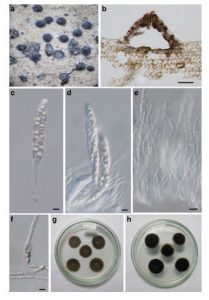Occultibambusa pustula D.Q. Dai & K.D. Hyde, sp. nov. Index Fungorum number: IF552018
Etymology: Refers to its pustule-like ascomata.
Holotype: MFLU 15–1212
Saprobic on decaying bamboo culms, forming black, rounded, pustule-like spots on host surface, with immersed ascostromata on raised areas. Sexual morphs: Ascostromata 150–200 μm high, 200–300 μm diam., immersed, subepidermal, slightly conical, black, with acentrally located ostiole. Peridium 30–80 μm thick, composed of brown and thick-walled to hyaline and thin-walled textura angularis, upper peridium combined with epidermal cells. Hamathecium composed of dense, long, up to 2 μm wide, cellular pseudoparaphyses above the asci. Asci 80–105 × 8–12 μm (x = 90.4 × 11.4 μm, n = 20), 8-spored, bitunicate, cylindrical, with a short furcate pedicel, with a shallow ocular chamber. Ascospores 22–25 × 5–5.5 μm (x = 21.6 × 5.3 μm, n = 20), 2–3-seriate, slightly broad-fusiform, 1-septate, hyaline to pale brown, guttulate, surrounded by a gelatinous sheath. Asexual morphs: Undetermined.
Culture characters: Ascospores germinating on PDA within 24 h and germ tubes produced from both ends. Colonies growing slowly on PDA, reaching 40 mm in 2 weeks at 28 °C, under 12 h light/12 h dark, circular,edge regular, flocculent, dark brown from above and below. Mycelium superficial to immersed in media, composed of branched, septate, smooth hyphae.
Material examined: THAILAND, Chiang Rai, Mae Fah Luang University, on dead culm of bamboo, 19 July 2011, Dong-Qin Dai DDQ00081 (MFLU 15–1185, holotype); Ibid. (KUN HKAS88695, isotype), ex-type living culture, MFLUCC 11–0502.
Notes: Occultabambusa pustula is similar to O. bambusae in having broad fusiform, 1-septate ascospores, but the latter has darker brown ascospores. Further distinctions between O. pustula and O. bambusae is that the former has raised and darker ascomata and there are also colony differences. Branch length in the phylogenetic tree (Fig. 13) shows that they are different species with high bootstrap support value (97/100 % MPBP/MLBP, BYPP greater than 0.90).
FIG. Occultibambusa pustula (MFLU 15–1185, holotype). a Appearance of ascostromata on bamboo. b Vertical section of ascostromata. c, d Asci. e Pseudoparaphyses. f Germinating ascospores. h, i Culture on PDA. Scale bars: b = 50 μm, c–f=5 μm

